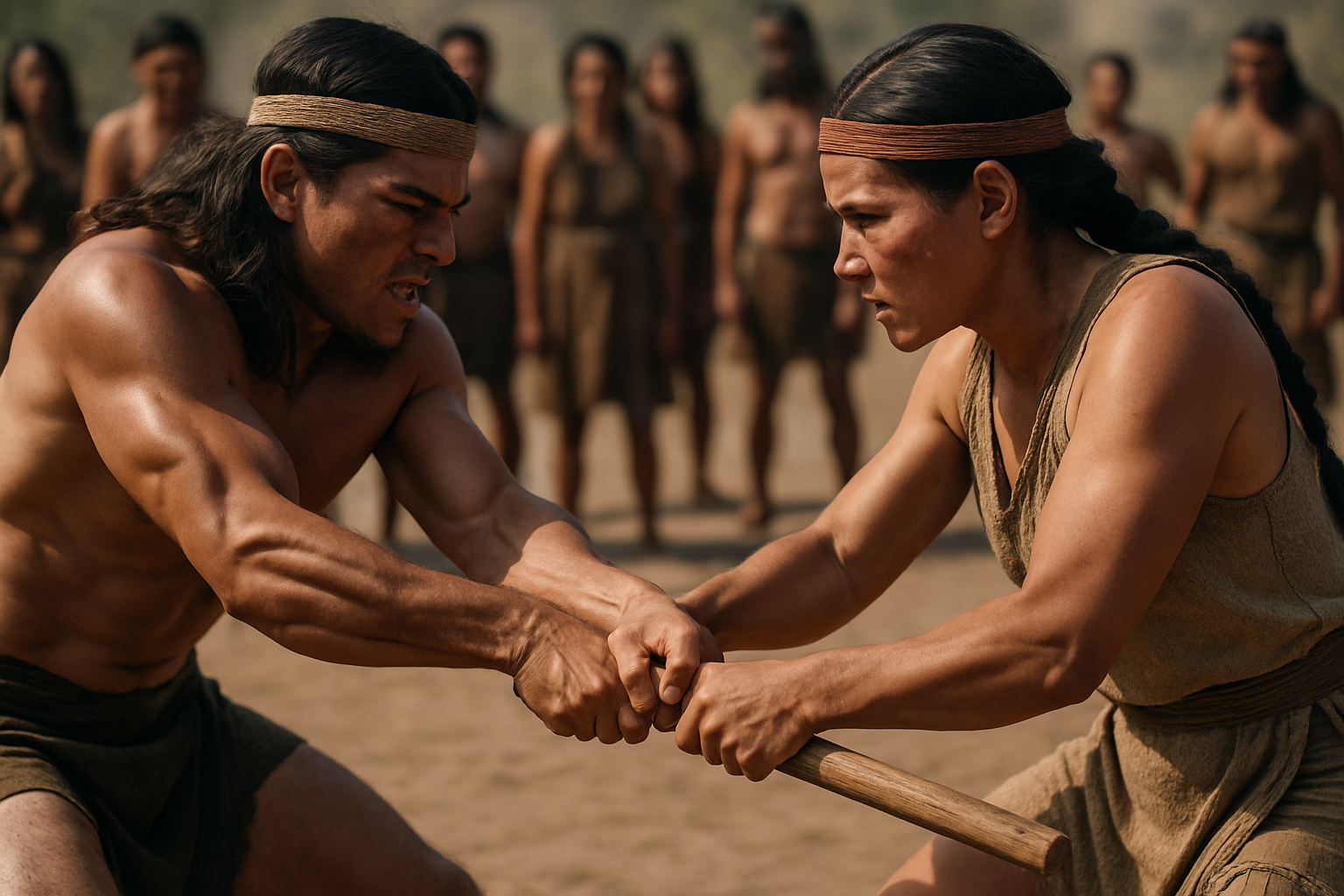Rediscovering the Ancient Art of Stick Wrestling
In a world dominated by high-profile sports and global athletic spectacles, an age-old tradition quietly endures, captivating those who seek the raw essence of physical competition. Stick wrestling, a practice rooted in ancient cultures, is experiencing a resurgence among athletes and enthusiasts searching for authentic, primal forms of sport. This centuries-old discipline combines strength, strategy, and cultural heritage, offering a unique window into the evolution of human combat and cooperation.

The Origins and Cultural Significance of Stick Wrestling
Stick wrestling’s roots can be traced back thousands of years, with evidence of its practice found in ancient civilizations across the globe. In Africa, stick fighting and wrestling have been integral parts of tribal culture for centuries. The Zulu and Xhosa peoples of South Africa, for instance, have long engaged in “umgangela,” a form of stick fighting that serves as both a martial art and a rite of passage for young men.
In Europe, stick wrestling took various forms, from the Irish shillelagh fights to the Swiss schwingen, where wrestlers grapple while holding onto short wooden sticks or each other’s specialized shorts. These traditions were not merely sports but often served as methods of conflict resolution, tests of manhood, and celebrations of cultural identity.
The cultural significance of stick wrestling extends beyond mere competition. In many societies, it played a crucial role in maintaining social order, settling disputes, and preparing warriors for battle. The skills honed in stick wrestling – balance, timing, strength, and strategy – were directly applicable to real-world combat scenarios, making it an essential part of military training in many ancient cultures.
Moreover, stick wrestling often held spiritual significance. In some African tribes, the stick used in combat was believed to possess magical properties, imbued with the strength of ancestors. The rituals surrounding stick wrestling matches often included prayers, blessings, and ceremonial practices that reinforced community bonds and cultural values.
The Mechanics and Variations of Stick Wrestling
At its core, stick wrestling involves two competitors grappling while holding onto a stick or pole. However, the specific rules, techniques, and objectives vary widely across different cultural traditions. In some forms, the goal is to force the opponent to release their grip on the stick, while in others, competitors aim to unbalance their opponent or force them out of a designated area.
The Ethiopian stick wrestling tradition, known as “Donga,” is particularly noteworthy. Practiced by the Surma and Mursi tribes, Donga involves combatants wielding long, slender poles. The objective is to strike the opponent while avoiding being hit, combining elements of fencing, wrestling, and stick fighting. The matches are intense, requiring great skill and bravery, and are often held as part of courtship rituals or to settle inter-tribal disputes.
In contrast, the Basque sport of “makila” focuses more on technique and leverage than striking. Competitors grasp a short stick with both hands and attempt to unbalance their opponent or force them to release their grip. This form of stick wrestling emphasizes lower body strength, balance, and strategic positioning.
The diversity of stick wrestling styles reflects the ingenuity of different cultures in adapting the basic concept to their specific needs and environments. From the icy plains of Mongolia to the tropical beaches of the Pacific Islands, each variation of stick wrestling tells a unique story of human adaptation and cultural expression.
The Physical and Mental Benefits of Stick Wrestling
While stick wrestling may seem primitive compared to modern sports, it offers a comprehensive workout that engages multiple muscle groups and develops functional strength. The constant pushing, pulling, and maneuvering involved in stick wrestling builds core strength, improves balance, and enhances grip strength – all essential components of overall fitness.
Dr. Sarah Thompson, a sports physiologist at the University of Cambridge, notes, “Stick wrestling is an excellent full-body workout that improves not just muscular strength but also proprioception and kinesthetic awareness. The dynamic nature of the sport requires practitioners to constantly adjust their body position, which can lead to improved coordination and agility.”
Beyond the physical benefits, stick wrestling offers significant mental and cognitive advantages. The sport requires quick thinking, strategic planning, and the ability to read an opponent’s intentions. These skills translate well to other areas of life, improving decision-making abilities and enhancing cognitive flexibility.
Furthermore, the intense, one-on-one nature of stick wrestling fosters mental resilience and emotional control. Practitioners must learn to manage stress, control their emotions, and maintain focus under pressure – skills that are invaluable in both athletic pursuits and everyday life.
The Revival of Stick Wrestling in Modern Times
In recent years, there has been a growing interest in traditional and indigenous sports, leading to a revival of stick wrestling in various parts of the world. This resurgence is driven by a combination of factors, including a desire to preserve cultural heritage, the search for authentic physical challenges, and the growing popularity of functional fitness practices.
Organizations like the World Ethnic Games Confederation have played a crucial role in promoting stick wrestling and other traditional sports on a global stage. These efforts have not only helped preserve ancient practices but have also fostered cross-cultural understanding and appreciation.
In South Africa, stick fighting academies have sprung up in urban areas, teaching the traditional art to a new generation of practitioners. These academies not only focus on the physical aspects of the sport but also emphasize its cultural significance and ethical principles.
Similarly, in Europe, traditional wrestling styles that incorporate stick elements, such as Gouren in Brittany and Scottish Backhold, are experiencing renewed interest. Annual competitions attract participants from around the world, blending the preservation of tradition with the excitement of modern sporting events.
The Role of Stick Wrestling in Cultural Preservation
As globalization continues to homogenize cultures worldwide, traditional practices like stick wrestling serve as important anchors of cultural identity. By maintaining and reviving these ancient sports, communities can preserve their heritage and pass down valuable knowledge to future generations.
Dr. Elena Rodriguez, an anthropologist specializing in sports and culture, explains, “Stick wrestling is more than just a physical contest. It’s a living museum of cultural practices, embodying the values, beliefs, and history of the communities that practice it. By keeping these traditions alive, we maintain a vital link to our past and ensure the diversity of human cultural expression.”
Many indigenous communities have recognized the potential of stick wrestling as a tool for cultural revitalization. In Australia, for example, some Aboriginal communities have incorporated traditional wrestling and stick fighting into youth programs, using these practices to teach young people about their heritage and instill a sense of pride in their cultural identity.
Moreover, the revival of stick wrestling has sparked interest in related cultural practices, from traditional music and dance to herbal medicine and craft-making. This holistic approach to cultural preservation ensures that the context and significance of stick wrestling are not lost, even as the sport evolves to meet contemporary needs.
Stick Wrestling in the Digital Age
While stick wrestling remains rooted in ancient traditions, it has not been immune to the influence of modern technology. Social media platforms and online video sharing have played a significant role in spreading awareness of stick wrestling and other traditional sports to a global audience.
YouTube channels dedicated to stick wrestling techniques and competitions have garnered millions of views, introducing the sport to people who might never have encountered it otherwise. These digital platforms have also facilitated knowledge exchange between practitioners from different cultural backgrounds, leading to cross-pollination of techniques and styles.
Virtual reality (VR) and augmented reality (AR) technologies are also beginning to impact the world of stick wrestling. Some developers are creating VR simulations that allow users to experience stick wrestling matches from different cultures, providing an immersive educational experience. While these digital representations cannot replace the physical practice, they serve as valuable tools for preserving and disseminating knowledge about stick wrestling techniques and traditions.
The Challenges and Opportunities for Stick Wrestling’s Future
Despite its recent revival, stick wrestling faces several challenges in the modern world. Safety concerns, particularly in more combative forms of the sport, have led to increased regulation and, in some cases, restrictions on practice. Balancing the preservation of authentic traditions with modern safety standards remains an ongoing challenge for practitioners and organizers.
Additionally, the sport must compete for attention and resources in a crowded athletic landscape dominated by more mainstream sports. Attracting young participants and securing funding for training and competitions can be difficult, particularly in urban areas where traditional practices may be seen as outdated or irrelevant.
However, these challenges also present opportunities for innovation and growth. Some stick wrestling organizations have successfully adapted their practices to appeal to a broader audience while maintaining the core principles of the sport. For example, the introduction of protective gear in some forms of stick fighting has made the sport more accessible to newcomers without compromising its essential character.
There is also growing interest from the fitness industry in incorporating elements of stick wrestling into mainstream workout routines. Fitness classes inspired by stick wrestling techniques offer a novel and engaging way for people to improve their strength, balance, and coordination.
The Global Community of Stick Wrestlers
One of the most exciting developments in the world of stick wrestling is the emergence of a global community of practitioners and enthusiasts. International competitions and cultural exchanges have created a network of stick wrestlers who share a passion for this ancient sport, transcending geographical and cultural boundaries.
The World Stick Wrestling Championship, held annually in different locations around the globe, brings together athletes from diverse backgrounds to compete and share their unique traditions. These events not only showcase the incredible skill and athleticism of stick wrestlers but also serve as forums for cultural exchange and mutual understanding.
Dr. James Lee, a sports sociologist at the University of Tokyo, observes, “The global stick wrestling community is a fascinating example of how traditional practices can adapt to the modern world. These athletes are not just preserving their heritage; they’re creating a new, interconnected culture that celebrates diversity while finding common ground in shared physical challenges.”
This global community extends beyond competitions. Online forums and social media groups dedicated to stick wrestling have become hubs for sharing techniques, discussing cultural significance, and organizing meetups. These digital platforms have been particularly valuable for practitioners in regions where stick wrestling is not widely practiced, allowing them to connect with like-minded individuals and continue their training.
Stick Wrestling as a Tool for Conflict Resolution
Historically, many forms of stick wrestling served as alternatives to more violent forms of conflict resolution. This aspect of the sport is being rediscovered and applied in modern contexts, particularly in areas of social tension or conflict.
In some parts of Africa, traditional stick fighting competitions are being used as a means of reducing inter-tribal violence. By channeling aggression into a structured, rule-based contest, these events provide a constructive outlet for competition and a platform for dialogue between communities.
Similarly, some youth programs in urban areas with high crime rates have introduced stick wrestling as part of conflict resolution training. The discipline, respect, and control required in stick wrestling can help young people develop alternative ways of dealing with confrontation and aggression.
Dr. Maria Sanchez, a conflict resolution specialist, explains, “Stick wrestling, when properly taught, instills values of mutual respect, self-control, and fair play. These principles are essential for peaceful conflict resolution. By engaging in this physical dialogue, participants learn to navigate confrontation without resorting to destructive violence.”
The Environmental and Sustainability Aspects of Stick Wrestling
In an era of increasing environmental awareness, stick wrestling stands out as a sport with a minimal ecological footprint. Unlike many modern sports that require extensive equipment or large, resource-intensive facilities, stick wrestling can be practiced with simple, natural materials in almost any setting.
This simplicity aligns well with growing interest in sustainable and eco-friendly sports practices. Some stick wrestling organizations have taken this a step further, incorporating environmental education into their programs. For example, a stick fighting academy in Brazil teaches participants about sustainable forestry practices as part of their training, emphasizing the importance of respecting and preserving the natural resources used in the sport.
Moreover, the connection to nature inherent in many stick wrestling traditions offers an opportunity to promote environmental stewardship. Many indigenous cultures that practice stick wrestling have a deep respect for the natural world, viewing their sport as a way of connecting with and honoring the environment.
The Therapeutic Potential of Stick Wrestling
While primarily viewed as a competitive sport or martial art, stick wrestling is beginning to attract attention for its potential therapeutic applications. The combination of physical exertion, mental focus, and cultural connection offers unique benefits that are being explored in various therapeutic contexts.
Some occupational therapists have begun incorporating modified stick wrestling exercises into rehabilitation programs for patients recovering from injuries or neurological conditions. The varied movements and grip strength required in stick wrestling can help improve motor control, coordination, and proprioception.
In mental health settings, the mindfulness aspects of stick wrestling are being utilized as a form of movement therapy. The intense focus required during practice can help individuals manage stress, anxiety, and depression by providing a physical outlet and promoting mental presence.
Dr. Robert Chen, a sports psychologist, notes, “The ritualistic nature of stick wrestling, combined with its physical demands, creates a powerful tool for mindfulness practice. Participants must be fully present in the moment, which can provide a respite from rumination and negative thought patterns.”
Stick Wrestling and Gender Equality
Traditionally, many forms of stick wrestling were exclusively male domains. However, the revival of these practices in the modern context has opened up opportunities for increased gender equality in the sport. Women’s participation in stick wrestling is growing, challenging long-held gender norms and expanding the sport’s appeal.
In some cultures, women’s stick wrestling competitions are now held alongside men’s events, attracting skilled athletes and enthusiastic audiences. These developments not only provide new competitive opportunities for women but also challenge traditional gender roles within the cultures where stick wrestling is practiced.
Sarah Johnson, a champion stick wrestler from the United Kingdom, remarks, “When I first started, people were surprised to see a woman in stick wrestling competitions. Now, it’s becoming more common, and we’re seeing incredible female athletes pushing the boundaries of the sport. It’s not just about athletic achievement; it’s about changing perceptions and opening doors for future generations.”
The inclusion of women in stick wrestling has also led to innovations in technique and strategy, as female practitioners adapt traditional methods to suit their strengths. This evolution demonstrates the sport’s capacity for growth and adaptation while maintaining its core principles.
The Educational Value of Stick Wrestling
Educational institutions are beginning to recognize the value of stick wrestling as a tool for teaching history, cultural studies, and physical education. Some schools have introduced stick wrestling programs as part of their curriculum, using the sport as a gateway to explore topics such as cultural diversity, historical conflict resolution, and the evolution of sports.
These programs often go beyond the physical aspects of stick wrestling, incorporating lessons on the cultural significance, ethical principles, and historical context of the sport. Students learn not just how to wrestle with sticks, but also about the societies that developed these practices and the values they embody.
Dr. Emily Thompson, an education researcher, explains, “Stick wrestling provides a tangible, experiential way for students to engage with history and culture. It makes abstract concepts concrete and helps students develop a more nuanced understanding of different societies and their practices.”
Moreover, the inclusivity of stick wrestling makes it an excellent tool for promoting cultural understanding and respect in diverse educational settings. Students from different backgrounds can share their cultural variations of the sport, fostering an environment of mutual learning and appreciation.
The Future of Stick Wrestling: Innovation and Tradition
As stick wrestling continues to evolve in the 21st century, the challenge lies in balancing innovation with the preservation of tradition. The sport’s future will likely be shaped by its ability to adapt to modern interests and concerns while maintaining the core elements that have made it endure for millennia.
One potential avenue for growth is the development of standardized international rules that would allow for more structured global competitions while still respecting regional variations. This could increase the sport’s visibility and appeal to a broader audience, potentially paving the way for inclusion in major multi-sport events.
Technological innovations may also play a role in stick wrestling’s future. The use of smart textiles and wearable technology could provide new ways to measure performance and enhance training, while also improving safety through real-time monitoring of athletes’ physical conditions.
However, as the sport evolves, practitioners and organizations must remain mindful of the importance of preserving its cultural heritage. The challenge will be to embrace new opportunities for growth and development without losing sight of the rich traditions and values that are at the heart of stick wrestling.
Dr. Ahmed Hassan, a sports historian, concludes, “The resurgence of stick wrestling represents a fascinating intersection of ancient tradition and modern sport. Its future will depend on the ability of practitioners and organizers to navigate the complexities of globalization, technological advancement, and cultural preservation. If successful, stick wrestling could serve as a model for how traditional practices can not only survive but thrive in the modern world.”
As we look to the future, stick wrestling stands as a testament to the enduring human desire for physical challenge, cultural expression, and connection to our shared heritage. In rediscovering this ancient art, we not only preserve a valuable piece of our collective past but also open new pathways for understanding ourselves and our place in the world. The stick, once a simple tool for survival, continues to be a bridge between cultures, generations, and the physical and spiritual realms of human experience.





